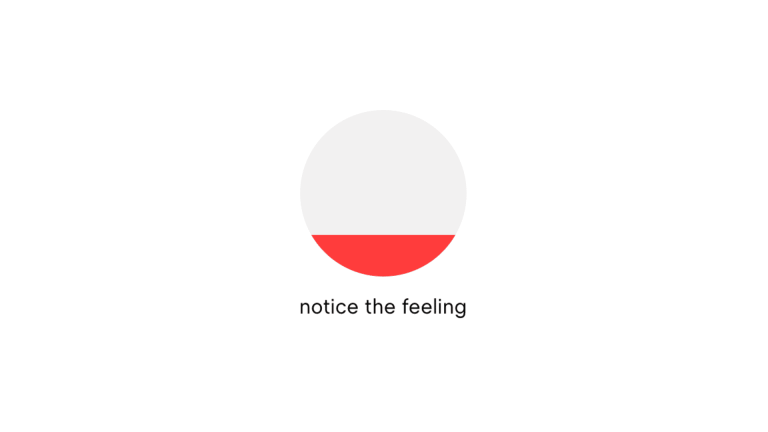“Just feel your feelings!” How many times have you heard this message, whether in social media posts, in articles about mental health, or from well-intentioned friends?
Unfortunately, this is often difficult to do because many of us have never actually been taught how to feel our feelings.
As a researcher on the psychology of happiness, I’ve seen how this can create problems for our well-being. Without knowing how to feel our feelings, it’s difficult to treat ourselves with compassion, make wise decisions, and grow as individuals.
Here’s a simple process I use:
Step 1: Notice the feeling.
Illustration: Stephanie Harrison of “The New Happy”
Take a deep breath in and out to center yourself. Then, turn inward and ask, “What feelings am I experiencing right now?”
Pay attention to any physical sensations that you’re experiencing. For example, you might be able to discern anger due to a tight sensation in your chest, or notice fear because of a jittery feeling in your hands or legs.
Step 2: Name the feeling.
Illustration: Stephanie Harrison of “The New Happy”
Putting your emotions into words makes them easier to manage.
How would you describe your emotional experience right now: annoyance, anger, envy, fear, disgust, disappointment, sadness, grief or something else? The more specific, the better.
Describe the feeling out loud with a phrase like, “I am experiencing disappointment right now.”
Step 3: Accept the feeling.
Illustration: Stephanie Harrison of “The New Happy”
Growing up, many of us were taught to suppress or hide our emotions. So as an adult, your first instinct might still be to push them away. You may think, “It’s wrong to feel that emotion.”
Research has found that suppressing our emotions can have negative consequences for both physical and mental well-being. Instead, we want to accept it.
This emotion is offering you the opportunity to make a different, healthier choice. Use a phrase like, “I accept that I’m feeling angry right now.”
Step 4: Be with the feeling.
Illustration: Stephanie Harrison of “The New Happy”
Once you’ve accepted the feeling, open up to it and fully experience it. The neuroanatomist Jill Bolte Taylor found that the physiological experience of an emotion lasts for just 90 seconds.
Commit to staying with the emotion for a minute and a half, giving it your full attention.
Step 5: Stay with the feeling until it changes.
Illustration: Stephanie Harrison of “The New Happy”
At a certain point, you will notice that the feeling has changed. You might now feel calmer, like a storm has passed. You also might notice another feeling emerging in its place.
This is a sign that you allowed yourself to fully experience the emotion
Step 6: Offer yourself compassion.
Illustration: Stephanie Harrison of “The New Happy”
Take a moment to offer kindness to yourself, to honor what you just experienced. There are many ways to do this, including:
- Putting your hand on your heart and saying, “I’m here for you.”
- Physically soothing yourself, by giving yourself a hug or taking a few deep breaths.
- Validating your experience with a phrase like, “I really felt sad just now.”
Step 7: Reflect on what the feeling has to teach you.
Illustration: Stephanie Harrison of “The New Happy”
It’s critical to remember that this emotion has a purpose. It can help you to better understand yourself, your life, and what you need the most. When we suppress our emotions, we cut ourselves off from this insight.
Ask yourself:
- What thought led to that feeling?
- How did my past experiences influence that thought?
- What does this feeling indicate about how my needs are being met?
- What lessons does that emotion have to teach me?
Step 8: Decide how you want to respond.
Illustration: Stephanie Harrison of “The New Happy”
Now that you’ve experienced your feelings and learned from them, you’re ready to respond with wisdom and make the best choice that you can.
That will look different depending on the situation. You might need to pause, gather more information, ask for help, prioritize a specific need, or reach out to connect with someone.
Ultimately, by using this process, you will be able to make a plan that will support your well-being, empower you to nurture your relationships and help you to achieve your goals.
Stephanie Harrison is the founder of The New Happy, an organization advancing a new philosophy of happiness. She is an expert in happiness, speaker, designer, and author of the forthcoming book “New Happy,” published by Penguin Random House. Follow her on Instagram, TikTok and LinkedIn.
Don’t miss:
Want to be smarter and more successful with your money, work & life? Sign up for our new newsletter here
Get CNBC’s free Warren Buffett Guide to Investing, which distills the billionaire’s No. 1 best piece of advice for regular investors, do’s and don’ts, and three key investing principles into a clear and simple guidebook.
Read the full article here









